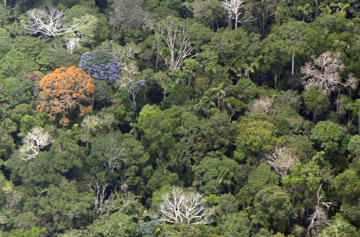New discoveries about past forest changes may help predict future ones in a changing climate
New discoveries about past forest changes may help predict future ones in a changing climate
Jeremy Hance, mongabay.com
June 12, 2008
|
|
There is no better method to understand the future than to look to the past. Several new studies of the earth’s glacial history are transforming the way scientists look at tree behavior during extreme changes in climate. Scientists Remj Petit, Feng Sheng Hu, and Christopher Dick described such changes in relation to current global warming in the new issue of the journal Science. They report that already ”
in some parts of the world, tree species have started to shift their distributions in response to anthropogenic climatic warming”, thus raising the stakes for understanding how tree species will adapt to coming changes.
Scientists have long believed that tree species must either migrate during climate change or face extinction. However, new fossil research has shown that some tree populations survived catastrophic changes in their temperatures: evidence of small tree stands have been found only tens of kilometers from glacier ice sheets while others were discovered on open land north of existing ice sheets during glacial periods. “Thus, it appears that small populations of trees can endure extreme climatic conditions for tens of thousands of years,” the scientists write.
 |
Yet, the paper points out that trees appear to be more suited to surviving a cooling climate rather than a warming one. Widespread extinction is certainly possible, as the paper points out 89 tree genera became extinct in Europe just before the beginning of the Quaternary. Using fossil and DNA studies, scientists were able to determine that two North American deciduous trees had the capacity to migrate at about 100 meters per year to survive a changing climate. Yet this will not be fast enough if global warming predictions are accurate: such trees would have to move 3,000-5,000 meters. These findings “[raise] interest in the possibilities of ‘assisted migration’—the translocation of populations to areas where future climate might be favorable”.
New genetic research has also shed light on trees ability to disperse over wide expanses. At one time it was believed that trees pretty much stuck to their own continent, but new research has shown that 13,000 years ago a kapok tree species migrated across the Atlantic Ocean from the Neotropics to Africa. Other trees went the opposite way. A study in Ecuador found that 21 percent of the species in a certain plot came from long-distance dispersal, possibly Africa, North America, the Caribbean, or somewhere else. Such studies allow scientists to better understand how new invasive species might take hold in faraway places during climatic change.
While these new findings are fundamentally changing the way scientists see the past–and view the present–they writers caution that such discoveries are not clear windows into the future. The research “cannot offer a direct guide to what we may have in stock for the future because the combinations of climate and other drivers (e.g., human land use) differ drastically between the past and the future,” however they do ” provide a way to examine climate-species relationships outside the modern realm and should help validate ecological models for simulating future changes”.
Rémy J. Petit, Feng Sheng Hu, and Christopher W. Dick (2008). Forests of the Past: A Window to Future Changes. 13 JUNE 2008 VOL 320 SCIENCE